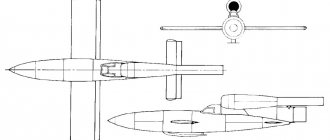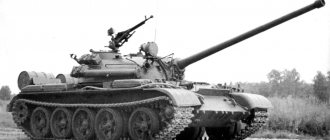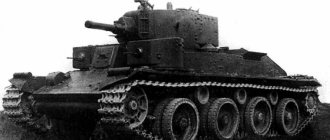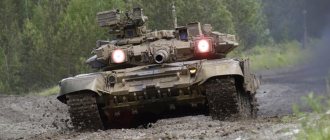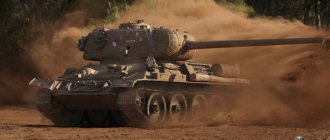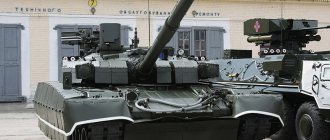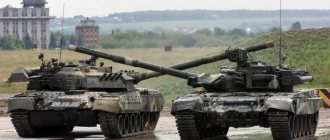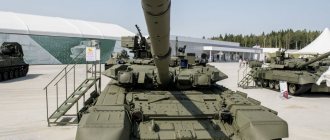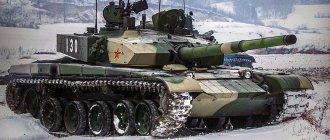In World War II, tanks were the main means of combat. Enormous amounts of money and intellectual resources were invested in their development and production. A very unique, innovative, but unfinished project is the E-100 tank. This is an experimental design for a super-heavy tank, invulnerable to most anti-tank guns of the time. The thickness of the frontal armor was 240 mm, which is a record for tanks of the 40s.
In modern times, the description of the E-100 looks like an advertisement for science fiction tanks and a computer game. Meanwhile, it is another development from the very real E series. By the end of the war, the prototype was 80% ready.
TTX E 100
As often happens, first of all it is worth saying that we have at our disposal not the largest, but a very significant margin of safety and, no less important, a good basic overview of 400 meters.
Needless to say, the E 100 has characteristics
bookings are excellent and survivability potential is very high. Let's start with the fact that the tower in the frontal projection has a thickness of 250 millimeters, but the 30-degree inclination of the frontal plate increases this figure to 289 millimeters; some PT-10s or with the help of gold can penetrate us here.
Regarding the hull, it makes no sense for this German to shoot at the VLD, since this is an E 100 tank
in real life it is about 440 millimeters, not counting the additional rotation of the body and other things. But the NLD in our case is very vulnerable, its thickness is only 230 millimeters, so it needs to be hidden in any situation.
In addition, there are two more vulnerable spots in the frontal projection: • A small strip on the roof of the tower (painted orange on the model's frame) has a thickness of 250 millimeters; • The base of the tower does not have slopes, so the armor here is also 250 millimeters, enemies falling here can cause damage.
Now let's pay attention to the sides, which are also very thick on our giant. If the heavy German tank E 100
shows the side at an angle from behind the building, while hiding the NLD; the reduction here also exceeds 400 millimeters, even with a slight additional rotation. In addition, there is a screen along the entire side, which serves as excellent protection against any cumulative projectiles.
But as you all understand, you have to pay for such impressive weapons, and mobility becomes the price. Maximum speed for E 100 World of Tanks
low, the ratio of horsepower per ton of weight is weak and we also spin very slowly.
see also
Used in the past
- Jagdtiger - was developed in 1942-1944. on the chassis of the Tiger II heavy tank and became the heaviest mass-produced armored vehicle of all time (75.2 tons).
- Self-propelled mortar "Karl" - a German heavy self-propelled mortar of the Second World War. Combat weight - 126 tons. A concrete-piercing projectile weighing 2170 kg pierced a concrete wall 3 to 3.5 m thick or a steel slab 450 mm thick.
- Object 279 is a heavy tank developed in 1957; was intended to break through prepared enemy defenses and operate in areas of terrain difficult for conventional tanks.
- Nuclear tank - a tank with a nuclear power plant
- The Tsar Tank is the largest armored ground combat vehicle ever built.
- Weapon of Vengeance
Currently in use
- NASA's Crawler Transporter, created for the 1965 Moon mission, weighs 2,400 tons and consists of a platform on eight tracks.
- The Bagger 288 is an excavator that is the largest self-propelled unit in the world, weighing 13,500 tons.
Fictional
- Bolo is a fictional super-heavy tank with artificial intelligence, weighing over 1000 tons.
- Ableben is a nuclear-powered tank weighing 1500 tons. To: Wikipedia: Articles without sources (type: not specified) [ source not specified 1960 days
] - Tank "Mammoth" In the memoirs of the protagonist of the story "Predatory Things of the Century" - a heavy assault tank (according to the original text).
- The super-heavy tank in the Command & Conquer
is a unique symbol of the game. Also, it is “Mammoth” that is the personification of the C&C rush, which consists of building a huge avalanche of tanks, which is extremely difficult to destroy with anything other than the same avalanche. Also - in the Red Alert series there is a Soviet tank Apocalypse, similar to the Mammoth.
gun
The situation with weapons in the case of this giant is very interesting, the gun available to us is excellent and powerful, but not everything is so simple, now you will understand everything yourself.
The fact is that after pumping out and purchasing a heavy tank E 100
, you don't get it in the top configuration. The initially installed gun does not have enough one-time damage, and although the DPM is almost as good as the top gun, and also has more comfortable accuracy, you won’t be able to get all the pleasure from playing with this gun. But it’s worth saying that you can play with it quite well, it’s quite decent.
But it’s much nicer when there’s a gun on the E 100
It costs top-end, because it has a truly powerful alpha strike and even a long reload will not prevent you from inflicting about 2250 units of pure damage per minute.
If we talk about the penetration of our gun, it is good, it is enough for most situations, but for head-on collisions with enemy heavy weapons it is not enough. For such cases, the E 100 WoT tank
should have about 15 cumulative shells with you, just remember that you cannot shoot them at tracks and screens, try to target vulnerable areas.
It is quite obvious that for the opportunity to knock out more than 700 points of strength from an enemy tank, you have to sacrifice accuracy. This means that the E 100 World of Tanks
large spread, long mixing, but apparently due to poor mobility, and also provided that the equipment and perks are correctly selected, the stabilization at our disposal is quite good and there is no great discomfort.
Yes, by the way, heavy tank E 100
has rather mediocre elevation angles, the gun bends down by 7 degrees, this is not so little, but in some cases it can get in the way.
What is better to put?
The standard set of equipment has one thing that is best left until the installation of new equipment and modules - a fire extinguisher. This module is the most indispensable for all E-100.
As for equipment, the first slot should be occupied by a gun rammer, and the second by a vertical stabilizer. You can experiment with the last remaining space. Many World of Tanks guides on the U-100 recommend taking a closer look at improved ventilation, enhanced aiming drives, or coated optics.
Advantages and disadvantages
I think everyone understands that we are now talking about a really strong and powerful tank, however, the truth lies in the details. To play E 100 World of Tanks
It’s really good to be able to influence the outcome of the battle; you need to clearly understand the advantages and disadvantages of the machine.
Pros: • Large margin of safety and good visibility; • Excellent all-round booking; • Screened sides; • Powerful one-time damage; • Very large ammunition capacity. Disadvantages: • Presence of weak zones in the frontal armor (especially NLD); • Large dimensions of the tank; • Poor mobility; • Mediocre accuracy of the top gun; • Not the best vertical aiming angles.
Equipment for E 100
Among the shortcomings of our tank there are points that can and should be corrected by installing additional modules. In addition, it never hurts to improve the existing strengths of the heavy lifting and you need to do all this wisely. So that you don’t rack your brains for a long time, the equipment for the E 100 tank
should be set in this form: 1. – our damage per minute is not that high, and it’s trivial to implement such a powerful alpha, we want to do it as often as possible. 2. – the accuracy of the gun leaves much to be desired, and as mentioned above, improving stabilization allows this to be corrected at least partially. 3. – will give an increase to such important parameters as rate of fire, aiming speed and visibility, what could be better?
However, despite all the benefits of the third module, there is a good and reasonable replacement for it -. The fact is that due to the huge dimensions and poor mobility along the E 100
Artillery loves to shoot, and the enemy, who cannot penetrate us, also loves to load landmines. By installing this module, we partially extend our life, and in this case it’s more pleasant to go for a ram.
Content
- 1 Concept 1.1 Problems of the concept
- 1.2 Sunset concept
- 2.1 France
- 3.1 Used in the past
Crew training
Another very effective way to improve the initial characteristics of a tank, which you should definitely use, especially when it comes to top-end equipment. In the case of E 100 perks
are pumped up in order to improve the survivability of the tank in every possible way, increase its firepower, and also influence several other important parameters, that is, the pumping scheme is as follows: • Commander – , , , . • Gunner – , , , . • Driver mechanic - , , , . • Radio operator – , , , . • Charger – , , , . • Charger – , , , .
My choice:
Equipment for E 100
Before you go into battle, you must remember that you have a real heavy tank in your hands, which often has to take a lot of damage, and in order to add to your life, as well as increase the benefits of being in battle, it is better to carry E 100 equipment
from , , , where, if there is a sufficient amount of silver, the last item can be replaced by . But when playing on this German, the costs are often high and periodically the reserves of silver credits begin to run out, in such situations you can buy, , .
About tanker perks
Several crew members who switch to the new model will have sets of the following skills with them:
- sixth Sense;
- repairer;
- member of the military brotherhood;
- eagle eye skill;
- radio interceptor;
- use of the main rotation of the tower;
- cleanliness and tidiness.
The last tanker will be able to protect the E-100 from fire, the chance of which increases after an enemy hit on the lower front plate. If the player manages to keep track of this detail and hide it from the enemy in time, then he can pay attention to other skills: virtuoso, main move, or even ramming master.
Tactics for playing E 100
The tank we are talking about now is a real rock, it is created in order to “absorb” a lot of damage with the least harm to itself, and, accordingly, to the entire team. In addition, we have excellent weapons at our disposal, but the main disadvantage is mobility, for this reason on the E 100 tactics
combat comes down to choosing one flank with the aim of protecting it from the enemy and/or further pushing through.
So, you must choose the directions for attack in advance, while the report is going on before the start of the battle. At the same time, make sure that when you reach the desired point, according to your E 100 World of Tanks
artillery could not fire and you had a place where you could stand on which you could hide your vulnerable zones and tank, “absorb” the damage, enjoy the sounds of ricochets and your importance in the battle.
Let me remind you that for more efficient tanking, the German heavy tank E 100
must hide the NLD, and also constantly dance (move back and forth, wiggle the body left and right) to make it more difficult for opponents to target the base of the tower, cheeks, and roof bar.
The ideal option would be tanking on the side, while the frontal projection of the E 100 WoT
should be hidden behind some obstacle, and the turret should stand level, forming a monolithic wall together with the hull.
As soon as the enemy or opponents fire at you, we calmly move forward, target the weak spot in the armor of the most impudent one and knock out 750 units of safety from his carcass with our cumulative force. If shooting cumulative shells is too expensive for you, the E 100 tank
is capable of causing damage with armor-piercing blanks, but in such cases you need to aim even more carefully.
At the same time, you must remember to monitor the mini-map and the situation around you, beware of artillery, try not to let anyone on board and don’t let yourself get caroused. Remember, E 100 World of Tanks
- this is a very strong machine, but one in the field is not a warrior, superior numbers of opponents will always gain the upper hand, so it is always better to act in tandem with one or more allies.
An excerpt characterizing the Super-heavy tank
- What? What? – Natasha asked. “This is this, that, that...” said Sonya with a pale face and trembling lips. Natasha quietly closed the door and went with Sonya to the window, not yet understanding what they were saying to her. “Do you remember,” Sonya said with a frightened and solemn face, “do you remember when I looked for you in the mirror... In Otradnoye, at Christmas time... Do you remember what I saw?..” - Yes, yes! - Natasha said, opening her eyes wide, vaguely remembering that Sonya then said something about Prince Andrei, whom she saw lying down. - Do you remember? – Sonya continued. “I saw it then and told everyone, both you and Dunyasha.” “I saw that he was lying on the bed,” she said, making a gesture with her hand with a raised finger at every detail, “and that he had closed his eyes, and that he was covered with a pink blanket, and that he had folded his hands,” Sonya said, making sure that as she described the details she saw now, that these same details she saw then. She didn’t see anything then, but said that she saw what came into her head; but what she came up with then seemed to her as valid as any other memory. What she said then, that he looked back at her and smiled and was covered with something red, she not only remembered, but was firmly convinced that even then she said and saw that he was covered with a pink, exactly pink, blanket, and that his eyes were closed. “Yes, yes, exactly in pink,” said Natasha, who now also seemed to remember what was said in pink, and in this she saw the main unusualness and mystery of the prediction. – But what does this mean? – Natasha said thoughtfully. - Oh, I don’t know how extraordinary all this is! - Sonya said, clutching her head. A few minutes later, Prince Andrei called, and Natasha came in to see him; and Sonya, experiencing an emotion and tenderness she had rarely experienced, remained at the window, pondering the extraordinary nature of what had happened. On this day there was an opportunity to send letters to the army, and the Countess wrote a letter to her son. “Sonya,” said the Countess, raising her head from the letter as her niece walked past her. – Sonya, won’t you write to Nikolenka? - said the countess in a quiet, trembling voice, and in the look of her tired eyes, looking through glasses, Sonya read everything that the countess understood in these words. This look expressed pleading, fear of refusal, shame for having to ask, and readiness for irreconcilable hatred in case of refusal. Sonya went up to the countess and, kneeling down, kissed her hand. “I’ll write, maman,” she said. Sonya was softened, excited and touched by everything that happened that day, especially by the mysterious performance of fortune-telling that she just saw. Now that she knew that on the occasion of the renewal of Natasha’s relationship with Prince Andrei, Nikolai could not marry Princess Marya, she joyfully felt the return of that mood of self-sacrifice in which she loved and was accustomed to living. And with tears in her eyes and with the joy of realizing a generous deed, she, interrupted several times by tears that clouded her velvety black eyes, wrote that touching letter, the receipt of which so amazed Nikolai. At the guardhouse where Pierre was taken, the officer and soldiers who took him treated him with hostility, but at the same time with respect. One could still feel in their attitude towards him doubt about who he was (whether he was a very important person), and hostility due to their still fresh personal struggle with him. But when, on the morning of another day, the shift came, Pierre felt that for the new guard - for the officers and soldiers - it no longer had the meaning that it had for those who took him. And indeed, in this big, fat man in a peasant’s caftan, the guards of the next day no longer saw that living man who so desperately fought with the marauder and with the escort soldiers and said a solemn phrase about saving the child, but saw only the seventeenth of those being held for some reason, by by order of the highest authorities, the captured Russians. If there was anything special about Pierre, it was only his timid, intently thoughtful appearance and the French language, in which, surprisingly for the French, he spoke well. Despite the fact that on the same day Pierre was connected with other suspected suspects, since the separate room he occupied was needed by an officer. All the Russians kept with Pierre were people of the lowest rank. And all of them, recognizing Pierre as a master, shunned him, especially since he spoke French. Pierre heard with sadness the ridicule of himself. The next evening, Pierre learned that all of these prisoners (and probably himself included) were to be tried for arson. On the third day, Pierre was taken with others to a house where a French general with a white mustache, two colonels and other Frenchmen with scarves on their hands were sitting. Pierre, along with others, was asked questions about who he was with the precision and certainty with which defendants are usually treated, supposedly exceeding human weaknesses. where he was? for what purpose? etc. These questions, leaving aside the essence of the life matter and excluding the possibility of revealing this essence, like all questions asked in courts, had the goal only of setting up the groove along which the judges wanted the defendant’s answers to flow and lead him to the desired goal, that is, to the accusation. As soon as he began to say something that did not satisfy the purpose of the accusation, they took a groove, and the water could flow wherever it wanted. In addition, Pierre experienced the same thing that a defendant experiences in all courts: bewilderment as to why all these questions were asked of him. He felt that this trick of inserting a groove was used only out of condescension or, as it were, out of politeness. He knew that he was in the power of these people, that only power had brought him here, that only power gave them the right to demand answers to questions, that the only purpose of this meeting was to accuse him. And therefore, since there was power and there was a desire to accuse, there was no need for the trick of questions and trial. It was obvious that all answers had to lead to guilt. When asked what he was doing when they took him, Pierre answered with some tragedy that he was carrying a child to his parents, qu'il avait sauve des flammes [whom he saved from the flames]. – Why did he fight with the marauder? Pierre replied that he was defending a woman, that protecting an insulted woman is the duty of every person, that... He was stopped: this was not getting to the point. Why was he in the yard of the house on fire, where witnesses saw him? He replied that he was going to see what was happening in Moscow. They stopped him again: they didn’t ask him where he was going, but why was he near the fire? Who is he? They repeated the first question to him, to which he said that he did not want to answer. Again he replied that he could not say that. - Write it down, this is not good. “It’s very bad,” the general with a white mustache and a red, ruddy face told him sternly. On the fourth day, fires started on Zubovsky Val. Pierre and thirteen others were taken to Krymsky Brod, to the carriage house of a merchant's house. Walking through the streets, Pierre was choking from the smoke, which seemed to be standing over the entire city. Fires were visible from different directions. Pierre did not yet understand the significance of the burning of Moscow and looked at these fires with horror. Pierre stayed in the carriage house of a house near the Crimean Brod for four more days, and during these days he learned from the conversation of the French soldiers that everyone kept here expected the marshal's decision every day. Which marshal, Pierre could not find out from the soldiers. For the soldier, obviously, the marshal seemed to be the highest and somewhat mysterious link in power. These first days, until September 8th, the day on which the prisoners were taken for secondary interrogation, were the most difficult for Pierre. On September 8th, a very important officer entered the barn to see the prisoners, judging by the respect with which the guards treated him. This officer, probably a staff officer, with a list in his hands, made a roll call of all the Russians, naming Pierre: celui qui n'avoue pas son nom [the one who does not say his name]. And, looking indifferently and lazily at all the prisoners, he ordered the guard officer to dress them decently and tidy them up before leading them to the marshal. An hour later, a company of soldiers arrived, and Pierre and thirteen others were taken to the Maiden Field. The day was clear, sunny after the rain, and the air was unusually clean. Smoke did not settle down like on the day when Pierre was taken out of the guardhouse at Zubovsky Val; smoke rose in columns in the clear air. The flames of the fires were nowhere to be seen, but columns of smoke rose from all sides, and all of Moscow, everything that Pierre could see, was one conflagration. On all sides one could see vacant lots with stoves and chimneys and occasionally the charred walls of stone houses. Pierre looked closely at the fires and did not recognize familiar quarters of the city. In some places, surviving churches could be seen. The Kremlin, undestroyed, loomed white from afar with its towers and Ivan the Great. Nearby, the dome of the Novodevichy Convent glittered merrily, and the bell of the Gospel was especially loudly heard from there. This announcement reminded Pierre that it was Sunday and the feast of the Nativity of the Virgin Mary. But it seemed that there was no one to celebrate this holiday: everywhere there was devastation from the fire, and from the Russian people there were only occasionally ragged, frightened people who hid at the sight of the French. Obviously, the Russian nest was ravaged and destroyed; but behind the destruction of this Russian order of life, Pierre unconsciously felt that over this ruined nest his own, completely different, but firm French order had been established. He felt this from the sight of those soldiers walking cheerfully and cheerfully, in regular rows, who escorted him with other criminals; he felt this from the sight of some important French official in a double carriage, driven by a soldier, driving towards him. He felt this from the cheerful sounds of regimental music coming from the left side of the field, and especially he felt and understood it from the list that the visiting French officer read this morning, calling out the prisoners. Pierre was taken by some soldiers, taken to one place or another with dozens of other people; it seemed that they could forget about him, mix him up with others. But no: his answers given during the interrogation came back to him in the form of his name: celui qui n'avoue pas son nom. And under this name, which Pierre was afraid of, he was now being led somewhere, with undoubted confidence written on their faces that all the other prisoners and he were the ones who were needed, and that they were being taken where they were needed. Pierre felt like an insignificant sliver caught in the wheels of a machine unknown to him, but functioning correctly. Pierre and other criminals were led to the right side of the Maiden's Field, not far from the monastery, to a large white house with a huge garden. This was the house of Prince Shcherbatov, in which Pierre had often visited the owner before and in which now, as he learned from the conversation of the soldiers, the marshal, the Duke of Eckmuhl, was stationed. They were led to the porch and one by one they were led into the house. Pierre was brought in sixth. Through a glass gallery, a vestibule, and an antechamber, familiar to Pierre, he was led into a long, low office, at the door of which stood an adjutant. Davout sat at the end of the room above the table, glasses on his nose. Pierre came close to him. Davout, without raising his eyes, was apparently coping with some paper lying in front of him. Without raising his eyes, he quietly asked: “Qui etes vous?” [Who are you?] Pierre was silent because he was unable to utter words. For Pierre, Davout was not just a French general; for Pierre Davout, he was a man known for his cruelty. Looking at the cold face of Davout, who, like a strict teacher, agreed to have patience for the time being and wait for an answer, Pierre felt that every second of delay could cost him his life; but he didn't know what to say. He did not dare say what he said during the first interrogation; revealing one's rank and position was both dangerous and shameful. Pierre was silent. But before Pierre could decide on anything, Davout raised his head, raised his glasses to his forehead, narrowed his eyes and looked intently at Pierre. “I know this man,” he said in a measured, cold voice, obviously calculated to frighten Pierre. The cold that had previously run down Pierre's back gripped his head like a vice. – Mon general, vous ne pouvez pas me connaitre, je ne vous ai jamais vu... [You couldn’t know me, general, I’ve never seen you.] – C’est un espion russe, [This is a Russian spy] – interrupted his Davout, addressing another general who was in the room and whom Pierre did not notice. And Davout turned away. With an unexpected boom in his voice, Pierre suddenly spoke quickly. “Non, Monseigneur,” he said, suddenly remembering that Davout was a Duke. - Non, Monseigneur, vous n'avez pas pu me connaitre. Je suis un officier militia naire et je n'ai pas quitte Moscou. [No, Your Highness... No, Your Highness, you could not know me. I am a police officer, and I have not left Moscow.] – Votre nom? [Your name?] - repeated Davout. - Besouhof. [Bezukhov.] - Qu'est ce qui me prouvera que vous ne mentez pas? [Who will prove to me that you are not lying?] - Monseigneur! [Your Highness!] - Pierre cried out in a not offended, but pleading voice. Davout raised his eyes and looked intently at Pierre. They looked at each other for several seconds, and this glance saved Pierre. In this view, apart from all the conditions of war and trial, a human relationship was established between these two people. Both of them in that one minute vaguely experienced countless things and realized that they were both children of humanity, that they were brothers. At first glance for Davout, who only raised his head from his list, where human affairs and life were called numbers, Pierre was only a circumstance; and, not taking the bad deed into account on his conscience, Davout would have shot him; but now he already saw a person in him. He thought for a moment. – Comment me prouverez vous la verite de ce que vous me dites? [How will you prove to me the truth of your words?] - Davout said coldly. Pierre remembered Rambal and named his regiment, his last name, and the street on which the house was located. “Vous n'etes pas ce que vous dites, [You are not what you say.],” Davout said again. Pierre, in a trembling, intermittent voice, began to provide evidence of the truth of his testimony. But at this time the adjutant entered and reported something to Davout. Davout suddenly beamed at the news conveyed by the adjutant and began to button up. He apparently completely forgot about Pierre. When the adjutant reminded him of the prisoner, he frowned, nodded towards Pierre and said to be led away. But Pierre didn’t know where they were supposed to take him: back to the booth or to the prepared place of execution, which his comrades showed him while walking along the Maiden’s Field. He turned his head and saw that the adjutant was asking something again. - Oui, sans doute! [Yes, of course!] - said Davout, but Pierre didn’t know what “yes” was. Pierre did not remember how, how long he walked and where. He, in a state of complete senselessness and dullness, not seeing anything around him, moved his legs along with the others until everyone stopped, and he stopped. During all this time, one thought was in Pierre’s head. It was the thought of who, who, finally sentenced him to death. These were not the same people who interrogated him in the commission: not one of them wanted and, obviously, could not do this. It was not Davout who looked at him so humanly. Another minute and Davout would have realized that they were doing something wrong, but this moment was interrupted by the adjutant who entered. And this adjutant, obviously, did not want anything bad, but he might not have entered. Who was it that finally executed, killed, took his life - Pierre with all his memories, aspirations, hopes, thoughts? Who did this? And Pierre felt that it was no one. It was an order, a pattern of circumstances. Some kind of order was killing him - Pierre, depriving him of his life, of everything, destroying him. From the house of Prince Shcherbatov, the prisoners were led straight down along the Devichye Pole, to the left of the Devichye Convent and led to a vegetable garden on which there was a pillar. Behind the pillar there was a large hole dug with freshly dug up earth, and a large crowd of people stood in a semicircle around the pit and the pillar. The crowd consisted of a small number of Russians and a large number of Napoleonic troops out of formation: Germans, Italians and French in different uniforms. To the right and left of the pillar stood fronts of French troops in blue uniforms with red epaulettes, boots and shakos.
